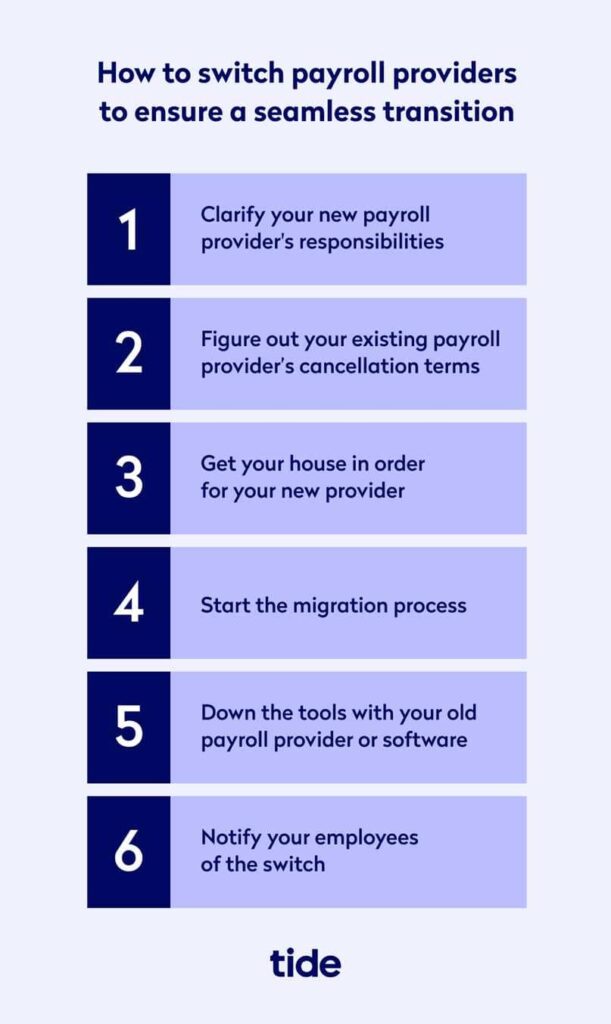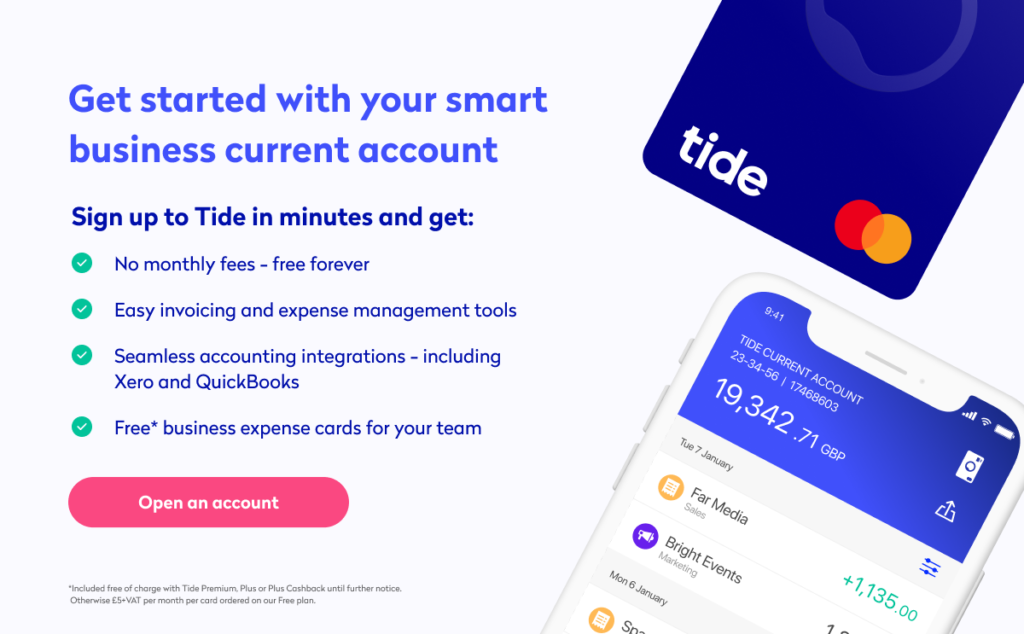
How to switch payroll providers for your small business

The right payroll provider (or software) can help you automate certain tasks, ensure compliance with HMRC, simplify tax filings and streamline financial processes and reporting.
That said, as your business grows, your payroll software needs may change. If that’s the case, you may want to switch payroll providers in order to pay employees more efficiently and effectively, as well as save time and money on running payroll.
In this article, we’re going to walk you through how to switch payroll providers, when the best time to switch is and explain exactly how to make that switch seamlessly.
Table of contents
- When is the best time to switch payroll providers?
- Considerations for switching payroll providers
- Can you switch payroll mid-year?
- How to switch payroll providers
- Payroll switching calendar
- Wrapping up
When is the best time to switch payroll providers?
Most payroll providers can take on new business at any time throughout the year. That said, the best time to switch is between tax years (e.g. in the weeks surrounding 5 April). If that’s not possible, the next best time to switch is between quarters.
Why? Because you won’t have to carry over any historical data from one tax year (or quarter) into the next.
This is important, because as a business owner you’re relying on your payroll provider to file several forms with HMRC on your behalf. To do this, they need detailed information about your business and your employees.
Top Tip: To see exactly what HMRC needs from your business, as well as tips to run a smooth payroll process, read our complete guide to payroll for small businesses 💰
Switching providers mid-year makes it crucially important to get this information to your new payroll provider as soon as possible. Any delay or mixup can leave you open to late fees or penalties from the government.
Switching with the new tax year means:
- Fewer compatibility issues. It’s possible that certain systems or processes between your current and new provider will not be compatible. For example, your old payroll provider may have various software applications for storing employee profiles and records, pay and benefits and performance tracking. If your new payroll provider uses one software program to record all of this data, migrating it over may be a painstaking and complex process (due to software incompatibility). Starting with a fresh slate can save you tons of time (and headaches).
- Less chance of human error. If there are parts of the switching process that cannot be automated, that information will need to be migrated manually. Even if you have a team of detail-oriented people at your disposal, human error is always a possibility. Switching in the new tax year eliminates this possibility.
- No new tax changes to keep track of. The UK government makes yearly changes to tax thresholds, rates and codes. Switching with the new tax year makes it straightforward to implement these changes and reduces the chance of incorrectly inputting updated tax information.
Switching at the end of the tax year (and the start of a new one) means that your new payroll provider can hit the ground running with all of the information they need.
Considerations for switching payroll providers
Before you decided to make the change, it’s important to understand what isn’t working with your current payroll provider and how a new one can solve that problem. Follow these steps to uncover existing pain points and future opportunities with a new provider:
- Audit what isn’t working with your existing provider (or software): The most important part of switching from one system to another is to identify what is not working so that you know exactly what you need your new system to do better.
- List your new must-have features: Besides what isn’t working with your current system, write down your must-haves with a new system to ensure nothing gets overlooked.
- Consider ease of use: How long will it take to get up and running with this new provider or software? Will the transition take a few days, weeks, or even months? Nail down your timeline and even plot it out on a calendar to ensure you don’t miss any deadlines.
- Check out their customer service reputation: Ideally, your payroll provider will be readily available to help you with any of your needs. This is especially true in the case of needing help in an emergency or helping you figure out a sticking point close to a payroll submission deadline. Check out their reputation online by reading reviews from existing customers to get the lay of the land.
- Consider integrations with accounting software: Integrations with accounting software mean one less step for getting key information into your payroll software or to your payroll provider. This goes along with the ease of use point above and is something that can save you a lot of time and money.
- Make sure it’s HMRC compliant: Of course, if your payroll provider is not HMRC compliant, you won’t be able to accurately report to HMRC. To ease this burden, HMRC has an entire page dedicated to helping you find HMRC-recognised software, both free and paid, if you don’t already have one.
- Analyse the costs: Not all payroll providers or software are created equal, and some have hidden fees and costs that you’ll need to consider. Make sure to heavily vet all potential costs before making a final decision.
- Ensure cross-compatibility: As we mentioned above, cross-compatibility will make the transition much easier, faster and reduce the chances of human error.
Can you switch payroll providers mid-year?
As we alluded above, you absolutely can switch your payroll provider or software mid-year if that is necessary for your business. If you do find that you need to switch mid-year, you need to proceed with a laser focus.
That’s because you’ll need to decide what your existing provider will take care of until a specific date, and what your new provider will manage thereafter. Detailed timelines are key, as:
- You don’t want this transition to affect your employees getting paid on time
- You don’t want provider overlap wherein they produce duplicate filings
- You don’t want to end up paying two providers at once
You should also double check the terms of your contract with your current provider. They may have cancellation fees associated with switching mid-year, so understanding the costs may influence your decision.
Also, consider what your new payroll provider will help you with. Some providers offer to manage the transition for you, where others won’t. Assess if taking on this workload mid-year will affect your productivity and workflows and if the risk is worth the reward.
How to switch payroll providers to ensure a seamless transition
Now that you know exactly what you are looking for in a new payroll provider, and have picked the right one for your business, it’s time to make the switch. Here’s a step-by-step checklist to help ensure a smooth transition.


Step 1: Clarify your new payroll provider’s responsibilities
HMRC makes it clear that you are legally responsible for keeping detailed records of your employee’s details.
That said, a payroll provider can keep and manage these records on your behalf. This includes providing payslips and making payments to HMRC for you (which are key parts of the PAYE tasks that make up payroll).
There are two broad categories of payroll services:
- Full-service payroll. This means that your payroll provider will do everything for you. All you need to do is give them your business information and employee data and they handle the rest.
- DIY payroll. This means that they do the hardest parts of payroll (i.e. calculating the pay and taxes) and leave smaller admin tasks to you.
You can also use payroll software, which is a combination of the two. For example, Tide payroll allows you to set up automatic pay runs, removing the need for manual entries and saving you time as a small business owner.
Ask yourself: would you prefer to track smaller things like employee leave and sickness absences, while tasking your payroll provider to focus on tax code notices, taxable expenses and benefits? Or, do you want your payroll provider to be in charge of every single factor related to payroll and wipe your hands clean of the admin altogether?
Once you know what your preference is, talk to your new payroll provider and make sure to explicitly clarify who will be responsible for what. This will reduce miscommunication and ensure a more seamless transition and operation.
Step 2: Figure out your existing payroll provider’s cancellation terms
Just as you need to organise your onboarding process with your new payroll process, you also need to come up with a smooth offboarding strategy.
If you have a contract that lasts a year and you’re eight months through, you may need to wait until the end of the contract to officially terminate your service. If you use payroll software, you’ll likely be able to cancel your subscription with greater flexibility.
Once you’re clear of any restrictions, contact your current provider, notify them that you are cancelling and ask what steps you need to take to begin the switch. Different providers will have varying requirements in regards to cancellation notice, so be sure to leave plenty of time just in case.
Step 3: Get your house in order for your new provider
Next up, reach out to your new payroll provider and ask them what they need from you to get started. Again, do this far in advance, as you’ll want to have a buffer in case certain tasks or paperwork take longer than expected to complete.
Here’s a list of what your new payroll provider may need from you (note that some of this information will not be needed if you are switching at the end of a tax year, such as employee tax codes, as you’ll be working off a fresh slate):
- Your business information. This includes your employer PAYE reference number, business structure, number of employees, and any other business information they request from you.
- Your employees’ details. Including their national insurance numbers, national insurance categories, tax codes, start dates, student loan amounts outstanding (if applicable), normal weekly hours worked, payment frequency (monthly, biweekly, weekly, etc.)
- Payroll records. This will likely include a record of all salary and wages payments, all deductions made, all staff leave and absences, copies of all PAYE coding notices (P9T) which have been received, every expense or benefit in kind provided and details of any contribution made by the employee.
Step 4: Start the migration process
The time has come! Talk to your new payroll provider (or reach out to an account manager or customer service rep with your new payroll software) to see exactly what you need to do in order to begin moving your information over.
You should also ask them what transition services they provide, as many providers will offer to handle all of the data entry and migration admin on your behalf in order to ease your burden.
Step 5: Down the tools with your old payroll provider or software
Send a final message to your current provider to remind them that you are cancelling and moving to a new provider. Now is a great time to double-check that you have in fact completed your to-do list in terms of shutting down your service in the right way, at the right time and that you have notified the right people.
The last thing you want to do is forget to confirm that everybody is on the same page and end up with two payroll providers billing you for their time or submitting duplicate paperwork to HMRC. It’s best to play it safe, cross your T’s and dot your I’s before you officially say goodbye.
Note: If you are changing payroll software, you may need to get new payroll ID’s, as certain solutions don’t let you use the same ones across various providers. If that’s the case, HMRC advises that you tick ‘Yes’ in the ‘Payroll ID changed indicator’ for each employee in your Full Payment Submission.
Step 6: Notify your employees of the switch
Keeping your employees in the loop will help you to get ahead of any confusion or potential misunderstandings.
For example, the payslips may look different from one provider to the next, which could cause concern if they didn’t know to expect this change. Stay ahead of any potential scenarios like this by being open and transparent from the start.
Payroll switching calendar
This payroll switching calendar will help you stay on top of the tasks you need to complete in a timely fashion to ensure a seamless transition.

Wrapping up
By following the steps laid out in this guide, switching payroll providers can be a breeze.
Make sure to have a clear understanding of your payroll needs, ask lots of questions and spend the time doing research to ensure your new payroll provider aligns with your needs and meticulously manage your switching process. Leave yourself plenty of time, communicate early and often with both your current and new payroll providers and get excited about the new benefits.
If you’re looking for a payroll solution that syncs directly with your start up business bank account, is fully HMRC compliant and even allows you to set up automatic pay runs, keep an eye out for Tide Payroll (coming soon!).
Photo by Tima Miroshnichenko, published on Pexels
Join our community of entrepreneurs, freelancers and small business owners
Tide is here to help small business owners and sole traders save time and money. Take a look at our Business Bank Account and get time back to focus on your business.








